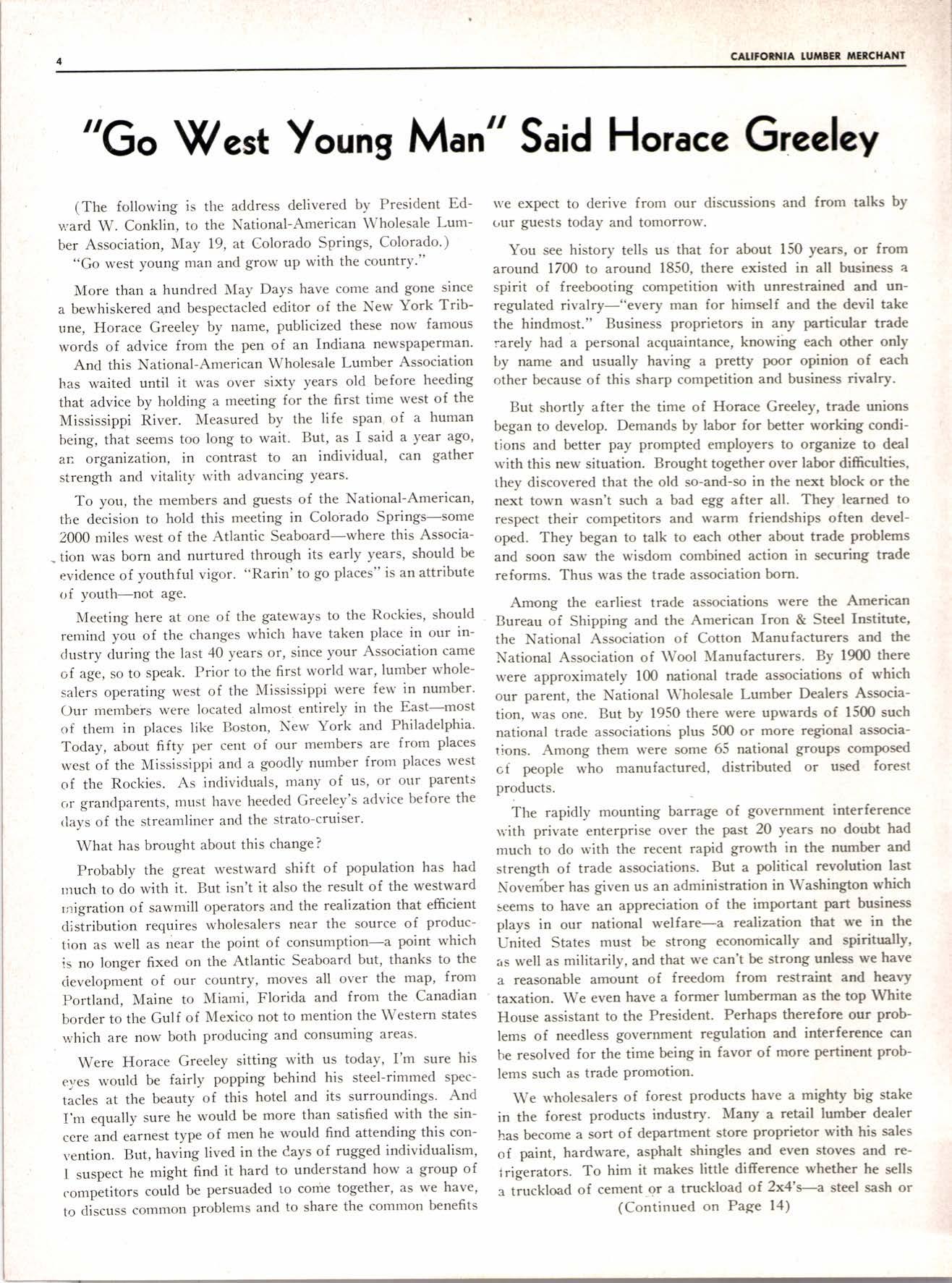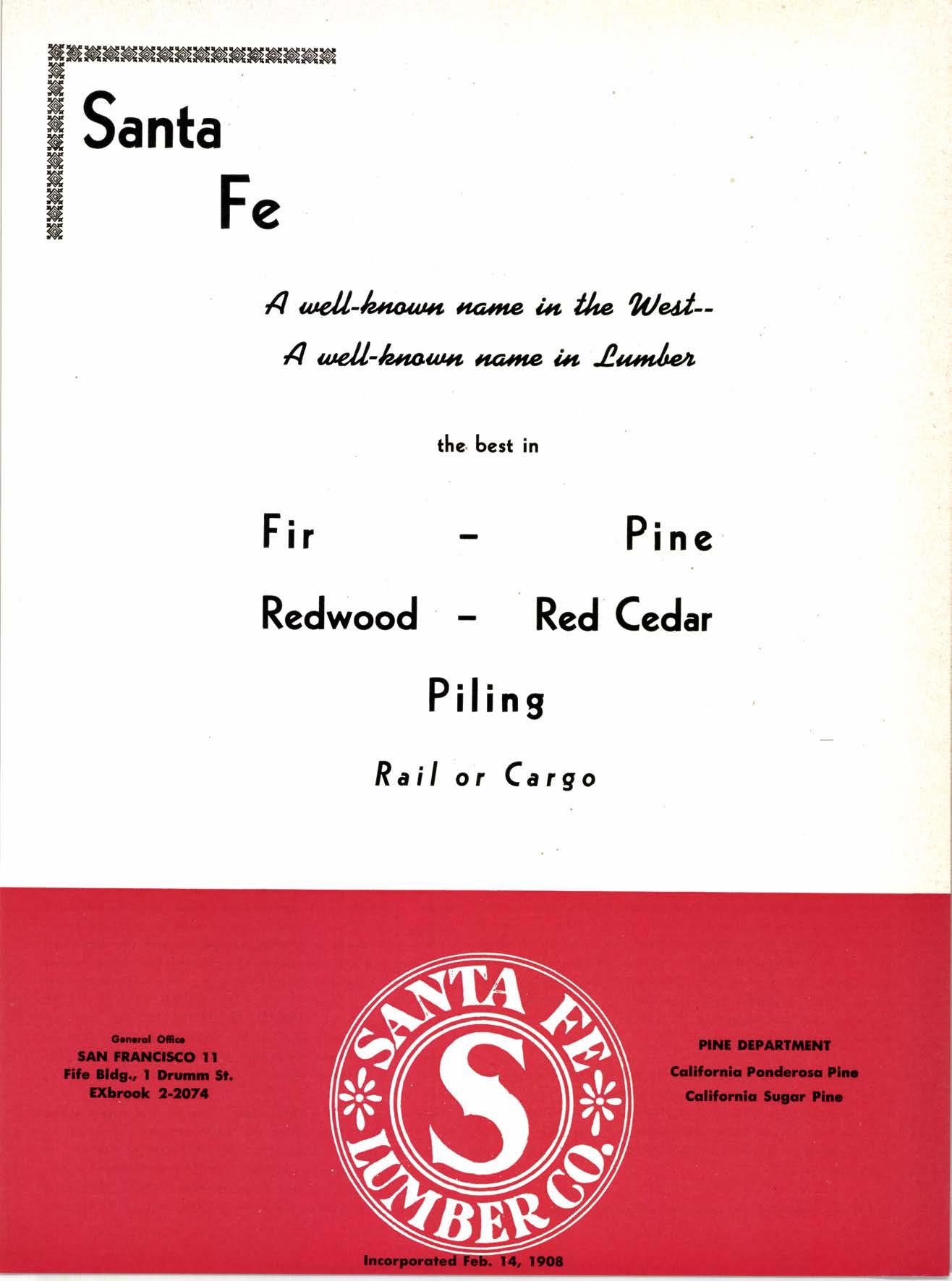
7 minute read
"Go \Yest Young Man" Said Horace GreeLv
(The following is the address delivered by President Edu'ard W. Conklin. to the National-American Wholesale Lumber Association, May 19, at Colorado Springs, Colorado.)
"Go west young man and grow up with the country'"
More than a hundred I\Iay Days have come and gone since a bewhiskered a.nd bespectacled editor of the New York Tribtune, Horace Greeley by name, publicized these now famous words of advice from the pen of an Indiana newspaperman'
And this National-American Wholesale Lumber Association has waited until it $'as over sixty years old before heeding that advice by holding a meeting for the first time west of the Mississippi River. Measured by the life span of a human being, that seems too long to wait. But, as I said a year ago' an organization, in contrast to an individual, can gather strength and vitality with advancing years.
To you, the members and guests of the National-American, the decision to hold this meeting in Colorado Springs-some 2000 miles west of the Atlantic Seaboard-where this Associa- tion was born and nurtured through its early years, should be evidence of youthful vigor. "Rarin' to go places" is an attribute of youth-not age.
Meeting here at one of the gateways to the Rockies, should remincl you of the changes which have taken place in our industry during the last 40 years or, since your Association came of age, so to speak. Prior to the first world n'ar, lumber wholesalers operating west of the Mississippi were few in number' Our membeis were located almost entirely in the East-most of them in places like Boston, New York and Philadelphia' Today, about fifty per cent of our members are from places west of the Mississippi and a goodly number from places west of the Rockies. As individuals, many of us, or otlr parents or grandparents, must have heeded Greelev's advice before the rlays of the streamliner and the strato-cruiser'
What has brought about this change?
Probably the great rvestward shift of population has had rnuch to do with it. But isn't it also the result of the westward rnigration of sawmill operators and the realization that efficient distribution requires wholesalers near the source of production as u'ell as near the point of consumption-a point which is no longer fixed on the Atlantic Seaboard but, thanks to the rievelopment of our country, moves all over the map, from Portland, Maine to Miami, Florida and from the Canadian border to the Gulf of Mexico not to mention the western states which are now both producing and consuming areas'
Were Horace Greeley sitting with us today, I'm sure his e),es would be fairly popping behind his steel-rimmed spectacles at the beauty of this hotel and its surroundings' And I'm equally sure he would be more than satisfied with the sinccre and earnest type of men he would find attending this con'r,ention. But, having lived in the Cays of rugged individualism, I suspect he might find it hard to understand how a group of competitors could be persuaded to come together, as we have, to discuss common problems and to share the comlnon benefits
\\'e expect to derive from our discussions and from talks by c,ur guests today and tomorrow.
You see history tells us that for about 150 years, or from around 1700 to around 1850. there existed in all business a spirit of freebooting competition with unrestrained and unregulated rivalry-"srery man for himself and the devil take the hindmost." Business proprietors in any particular trade mrely had a personal acquaintance, knowihg each other only by name and usually having a pretty poor opinion of each other because of this sharp competition and business rivalry.
But shortly after the time of Horace Greeley, trade unions began to develop. Demands by labor for better working conditions and better pay prompted employers to organize to deal with this new situation. Brought together over labor difficulties, they discovered that the old so-and-so in the next block or the next town wasn't such a bad egg after all. They learned to respect their competitors and warm friendships often developed. They began to talk to each other about trade problems and soon saw the wisdom combined action in securing trade reforms. Thus was the trade association born.
Among the earliest trade associations n'ere the American Bureau of Shipping and the American Iron & Steel Institute, the National Association of Cotton Manufacturers and the National Association of Wool \'lanufacturers. By 1900 there were approximately 100 national trade associations of which our parent, the National \\'holesale Lumber Dealers Association, was one. But by 1950 there were upwards of l5(X) such national trade associationi plus 500 or more regional associations. Among them w'ere some 65 national groups composed of people who manufactured, distributed or used forest products.
The rapidly mounting barrage of government interference r.vith private enterprise over the past 20 years no doubt had much to do rvith the recent rapid growth in the number and strength of trade associations. But a political revolution last Noveniber has given us an administration in Washington which seems to have an appreciation of the important part business plays in our national welfare-a realization that we in the United States must be strong economically and spiritually, as well as militarily, and that we can't be strong unless we have a reasonable amount of freedom from restraint and heavy taxation. We even have a former lumberman as the top White House assistant to the President. Perhaps therefore our prob' lems of needless government regulation and interference can be resolved for the time being in favor of nrore pertinent problems such as trade Promotion.
\Ve wholesalers of forest products have a mighty big stake in the forest products industry. Many a retait lumber dealer has become a sort of department store proprietor with his sales of paint, hardware, asphalt shingles and even stoves and reirigerators. To him it makes little difference whether he sells a truckload of cement or a truckload of 2x4's-a steel sash or (Continued on Page 14)

Charlie Buckner died just a short time ago. His death was a significant event in the history of the lumber industry, because his life and the work that he did during that lifetime, made an impression on this industry second to that of perhaps just one man. *

Charlie Buckner was a prophet. fle was just as much of a prophet in his time as old Isaiah was in his time. And you can add several other names of the soothsayers of the Old Testament to the list, and the statement above will still Prevail'
He was a prophet with regard to Douglas Fir Plywood. He was THE prophet in that respect. And the development and extended use of that material is the most momentous advance that has ever been made in the lumber industrlr of the West.
Perhaps the only a.".rJprri.tJ"rra "n"rrge in the lumber industry of the nation that eclipses in importance the coming of Plywood, was the coming of practical reforestation and tree growing. Today the entire industry, wherever lbcated, is in the tree growing business. That is the biggest thing that ever happened to this industry, because it has completely reborn the industry.
For more than a *.t.J.tJr, 1r,", .t " beginning of the present century the lumber manufacturing business had but one thought; cut your timber and move. Today from coast to coast and from tJre Gulf to Canada, we know better. But it took us a long time to find it out. And we owe it almost entirely to another prophet-the greatest of them all-the late Henry Hardtner, of Louisiana. Fifty years ago-more than that in fact-Henry Hardtner knew everything about practical reforestation and commercial tree growing that the wisest of the industry knows now. He lirrew it and could prove it.
But for a generatio" lnJ, i" "."r."a practicing and preaching the marvels that could be done with tree growing, most of the industry clung to the old-timey idea that you cut your virgin timber and move on. The smartest men in the industry listened to Mr. Hardtner, and laughed up their sleeves.
Let us mention one case in particular that we knew about. We will menuon no names. Both ttc principals are dead, and both were 6ne men. One of them was sawing second-growth Southern Pine in a Southern district back in 1912. A friend drove by and stoppcd for a visit T'lre visitor owned a lot of virgin Pine and a string of big mills***
He looked at the logs on the carriage and said to the mill operator: "Are you cutting second-growth timber?" The other allowed that he wag The first man said to hin: "Any man that cuts second-growth timber will dways scratch a poor man's head." ***
The point of the story is that the visitor in this casc cut all his virgin timber, and then went to cutting sccondgrowth, and practicing reforestation and tree growing. When he died the fact was known that he had made several times as much money AFTER he cut out his big trees and started cutting second-growth as he did on his great virgin forest. Others, many of them, have since learnsd that lesson' * * * we were proud "rth"i r;J but do you know solaething, Junior? Even then we were not dead surc in our own mind that he was right. We still said to ourself, "It takes 60 years to grow a short leaf Pine and nearly a hundred to grow a long leaf Pine, so who cares?" The great big light concerning selective cutting, selective logging,
Henry Hardtner was the other prophet besides Charlie Buckner that we have known in the business world. Just those two. The difference between ttre two is +!at they laughed at Henry Hardtner for his "absurd" ideas about growing trees for market. Buckner never had to go through that because when he hit the plynrood industry it was in its infancy, and the industry was not loaded down with preconceived notions about it. The industry knew nothing of plywood, and knew that it knew nothing.
The lumber industry i."*"ol. that it knew all about timber growth, and knew that what Henry Hardtncr preached could not be done. Away back in l9l8 the writer of this piece went to Urania, Louisiana, and tr. Hardtner took him through his woods and showed him what he was doing, and thus what could be done. \f,/e went home and printed a story about it in THE GULF COAST LUUBERMAN (the LUMBER MERCHANT was not yet born), and had a letter from Mr. Hardtner saying that we were the first visitor he'd ever had who seemed to understand what he was doing.










